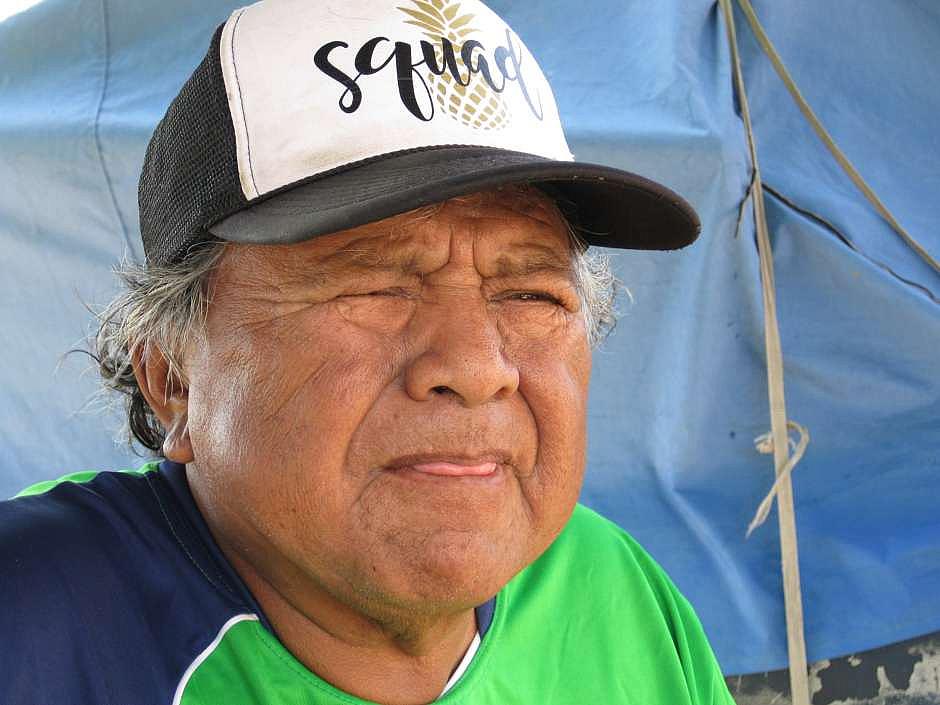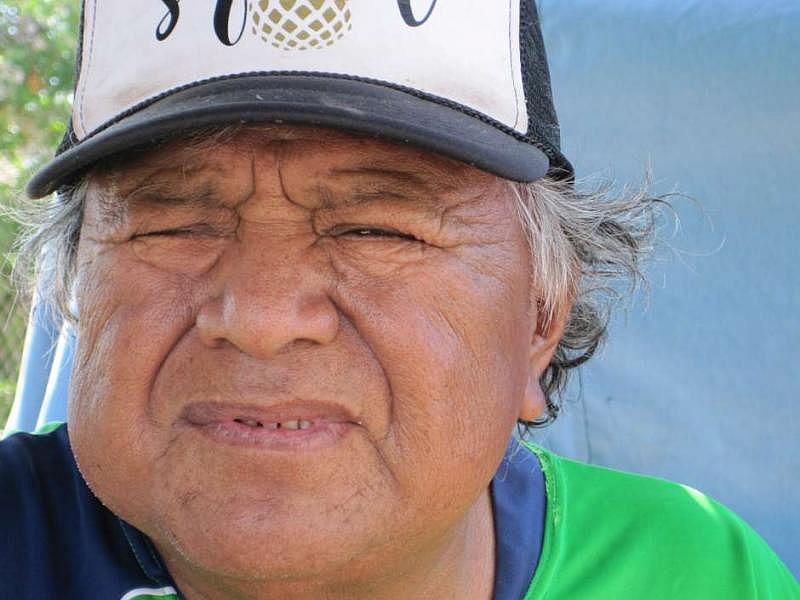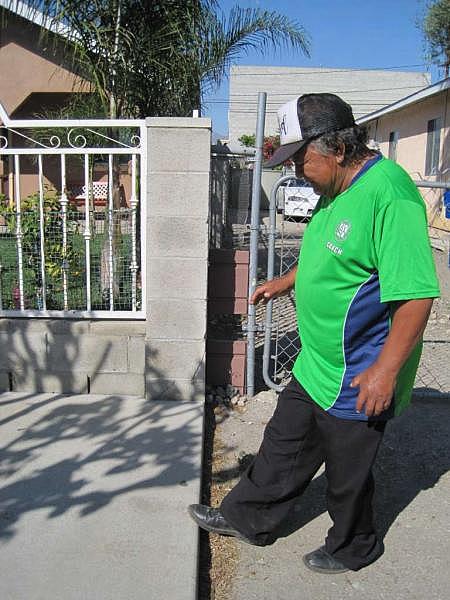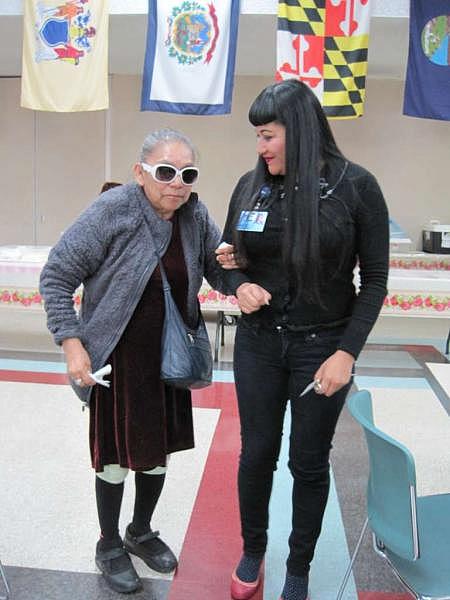'I feel like a prisoner' says man who lost his sight due to diabetes
Francisco Castro wrote this story while participating in the USC Center for Health Journalism‘s California Fellowship.
Other stories by Francisco Castro include:
Diabetes to dialysis, a life-threatening progression
Diabetes robs Latinos of prosperous lives
REPORTAJE: ¿Cómo la ‘teleterapia’ ha ayudado a víctimas de la violencia doméstica?
REPORTAJE: Violencia doméstica se agudiza en la pandemia entre mujeres inmigrantes
REPORTAJE: VAWA y Visa-U: alivios migratorios para sobrevivientes de violencia doméstica

Venancio Martinez is completely blind from his right eye. He only sees a little bit of clarity on his left, product of the diabetes he’s been suffering for 20 years. (Francisco Castro)
[Click HERE for Spanish version.]
In the courtyard of his Pacoima house, Venancio Martínez averts his eyes to the sun that seeps through the branches and leaves of the tree he’s sitting under.
His right eye is closed. And he squints out of his left.
But he can’t really see.
The sun is beating hard this afternoon, but Martínez is surrounded by darkness.
The reason for his blindness is the diabetes he’s been suffering for 20 years.
“From there onward, things got worse,” says the native of San Luis Potosi, Mexico.
According to the National Eye Institute (NEI), approximately 7.7 million people over the age of 40 suffer from a visual problem caused by diabetes. The ills associated with this are called diabetic retinopathy, diabetic macular edema (DME), cataracts, and glaucoma.
Four years ago Venancio Martinez started having kidney problems, also a result of diabetes. His organs barely work at 10-15% and needs constant dialysis treatments to stay alive. (Francisco Castro)
Dr. Joseph Wanski, an endocrinologist at L.A. Care, says that all of this is associated with blood pressure and sugar levels.
“Diabetic retinopathy causes the blood vessels in the back of the eye to weaken, bleed and cause loss of sight,” explains Dr. Wanski. “Blood vessels are more sensitive to high levels of sugar.”
In his experience, one in three people with diabetes has vision problems.
Some treatments may include eye injections, retinal lasers, or surgery. It is recommended that at the time of being diagnosed with diabetes the person should also take a vision exam and if the doctor does not see symptoms of diabetic retinopathy, it’s a good idea to have a vision test every year.
No one in Martinez’s family had ever had the disease. He remembers feeling relatively good in its early stages and did not feel the need to go to the doctor to check himself regularly.
The only thing he felt was that “I was hungry all the time and I was very thirsty”, he says of why he eventually went to see a doctor and received the diagnosis.
He adds that he was given medication, but by then the sickness had progressed.
“When I saw the letters, they looked double,” he recalls of the first signs of eye trouble.
He began to see little dark spots.
Then his right eye began to tremble.
One day he climbed into his car and “everything looked cloudy. I sat down to drive and I no longer could,” he says.
The doctor told him that the veins in her eyes were bursting because of the disease he had neglected.
He had two laser surgeries, but neither helped.
“Instead of helping me, they hurt me more,” he says. “I can’t do anything anymore.”
Fifteen years ago he lost eyesight completely in his right eye. The eyelid closed eventually.
Martinez walks along his block, his only outings after losing his sight due to diabetes. (Francisco Castro)
Nowadays, Martínez – who once worked at a factory where they made medical and airplane parts — is relegated to his home, where he lives alone. He pays a woman to cook for him and help him with other household chores that he can’t do for himself.
He doesn’t use a walking cane and he doesn’t have a guide dog.
However, “I know the street by heart,” he explains as he walks slowly along his block, stopping to clutch the wall from time to time and stumbling on the imperfections of the sidewalk.
His only other outings are to the doctor and to the dialysis treatments he attends three times a week, for three hours at a time. Like many diabetics, he is confined to the dialysis chair because his kidneys barely work.
“I don’t go very far because I’m afraid of getting lost,” he says. “It’s like being a prisoner.”
Her Sight Gone: She Seeks Independence at the Braille Institute
A friend referred Rosenda Guzmán to the Braille of Institute in Los Angeles, an agency that offers resources and reading classes to the blind.
Now the institute is doing more than teaching her the tactile reading and writing system that is part of its name. It’s helping her reclaim her life after diabetes slowly took her eyesight away.
“Here they teach one to walk, to cook, how to grab utensils to prevent us from getting cut,” Guzman, 61, explains.
There are also art sessions, and workshops on how to organize your closet, and do laundry.
Rocio Vallejos-Hoyt, Services Manager at the Braille Institute, leads Rosenda Guzman around the cafeteria of the agency that offers services to the blind. (Francisco Castro)
The first time she suffered diabetes was 26 years ago when she was pregnant with her youngest daughter.
According to the Mayo Clinic, blood sugar levels usually return to normal soon after the woman deliver. But women who have had gestational diabetes remain at risk.
Guzman’s diabetes returned years later.
“I did not take care of it,” she says. “I had no medicine, no health insurance, no Medi-Cal.”
In 2010 she ended up in the hospital when her right foot swelled. She spent a week there.
“The next day I couldn’t distinguish people,” she says. “I went into despair.”
She spent her days in bed, locked up in her bedroom
Rocío Vallejos-Hoyt, Services Manager at the Braille Institute, knows that pattern well. She has seen “people who stay in a corner and do not want to move.”
“The goal is for the person to regain independence and not depend on anyone, and know that the world does not end,” says Vallejos-Hoyt.
The institute provides assistance to all ages, from infants to seniors and to entire families, in English and Spanish. They do so regardless of immigration status and all services are free.
Guzman is slowly learning to live with her blindness. She’s left her bedroom for the kitchen to cook traditional meals from her homeland.
“As long as they don’t change the position of the things I use, I keep going it,” she says.
Her next step, literally, is to learn to walk on her own with a cane.
“I’m very afraid to cross the streets,” she says. “I don’t feel capable yet.”
Another client of the Braille Institute holds her arm and leads her around the grounds until she’s ready to do it on her own.
Resource Fair
The Braille Institute will hold a resource and informational fair for people and families of those with visual problems.
When: July 18
Time: 9:00 a.m. – 2:00 p.m.
Where: Braille Institute, 741 N. Vermont Ave., Los Angeles 90029
Information: (800) 272-4553.
[This story was originally published by La Opinion.]

